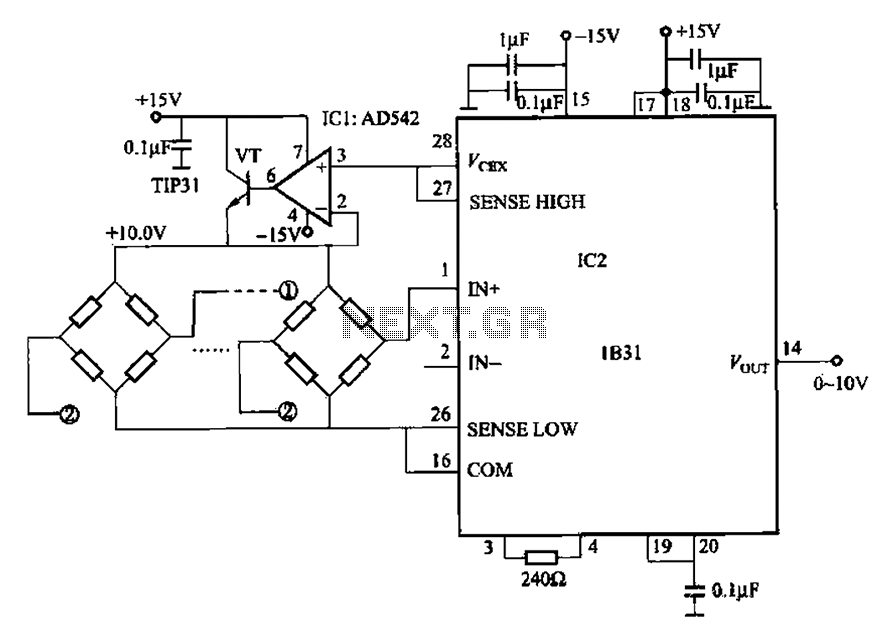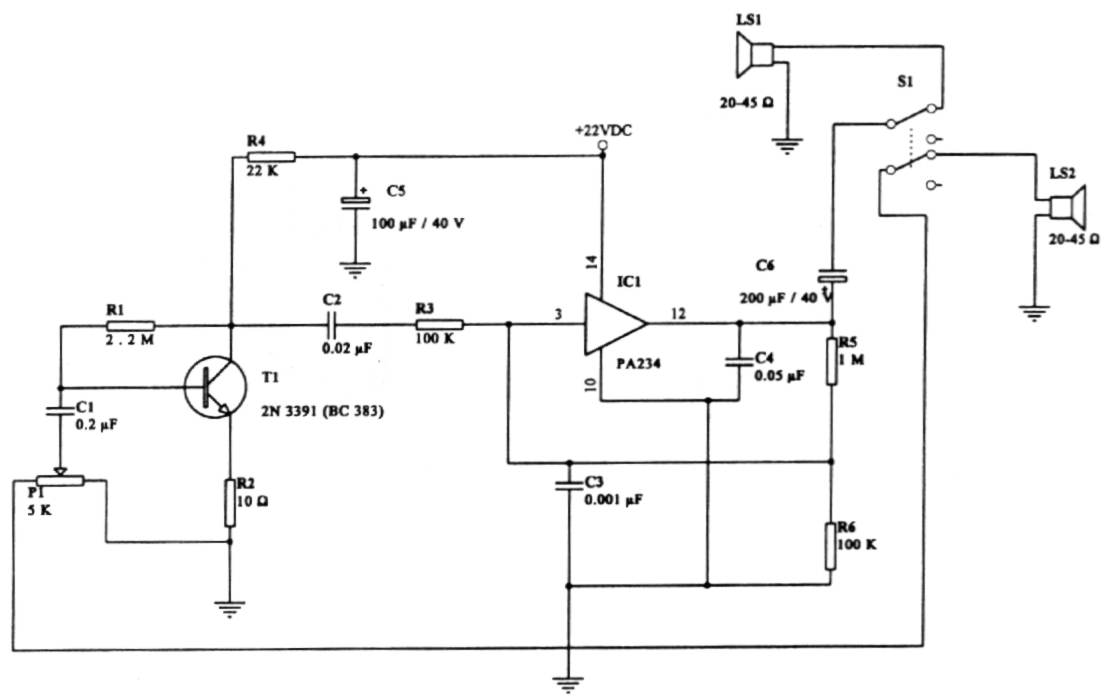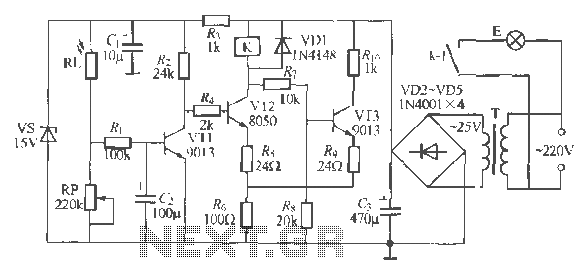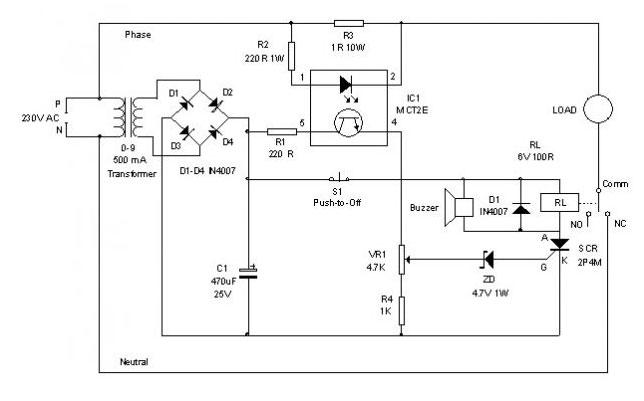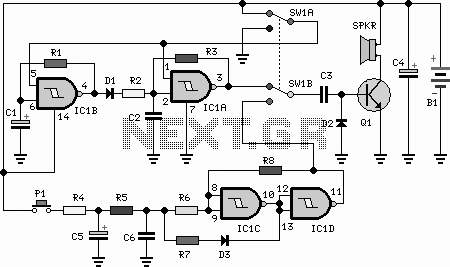
15dB UHF Antenna Preamp Circuit

This is a UHF band TV antenna preamplifier circuit with a gain of 15 dB, built using a BF180 UHF transistor. The circuit is straightforward in design. The operational principle consists of two stages. The first stage features a band-pass filter constructed with components C1, CV1, L1, L4, C7, and C3. The second stage is a common-base voltage amplifier with low input impedance to ensure proper matching. The inductors L1 to L4 should be constructed as air core coils to achieve a high Q-factor. After assembly, the circuit should be housed in a suitable metallic enclosure, and the circuit ground must be connected to the enclosure to minimize noise interference.
The UHF band TV antenna preamplifier circuit is designed to enhance the signal quality received by the antenna, making it particularly useful in areas with weak signal reception. The BF180 transistor serves as the active device in this circuit, providing the necessary amplification to improve the overall performance of the antenna system.
The first stage, which consists of the band-pass filter, is crucial for selecting the desired frequency range while rejecting unwanted signals. The components involved—C1, CV1, L1, L4, C7, and C3—work together to shape the frequency response of the circuit. C1 and CV1 are capacitors that, along with the inductors L1 and L4, form a resonant circuit that allows only the UHF frequencies to pass while attenuating others.
The second stage employs a common-base voltage amplifier configuration. This configuration is characterized by its low input impedance, which is beneficial for matching the output of the band-pass filter with the input of the amplifier. This matching is essential for maximizing power transfer and minimizing signal loss.
The inductors L1 through L4 should be constructed as air core coils to achieve a high Q-factor, which is indicative of the coil's quality and efficiency. A high Q-factor minimizes energy losses and enhances the selectivity of the filter. The construction of air core coils involves winding insulated copper wire around a non-conductive form, ensuring that the coils are spaced appropriately to avoid coupling and interference.
Once the circuit is assembled, it is recommended to place it inside a metallic enclosure. This enclosure serves multiple purposes: it protects the circuit from physical damage, shields it from electromagnetic interference, and helps to ground the circuit effectively. Proper grounding to the enclosure is critical as it helps to eliminate noise that could degrade the performance of the preamplifier, ensuring clearer signal reception.
Overall, this UHF band TV antenna preamplifier circuit represents a practical solution for enhancing signal strength and quality in UHF television reception applications.This is an UHF band TV antenna preamp circuit with 15dB gain and build by a transistor. It is formed based on BF180 UHF Transistor. This circuit is a simple circuit. This is a figure of the circuit. The principle operation of the circuit is two stages. The first stage is an band pass filter constructed by the C1, CV1, L1, L4, C7 and C3, the second stage is a base-common voltage amplifier with low input impedance to match. Build the L1 ~ L4 as air core coil to obtain high Q-Factor. You can find out about air core coil construction and calculation here. After assembling, pack it into a proper metallic box and connect the ground of the circuit to the box to reduce noise effect. 🔗 External reference
The UHF band TV antenna preamplifier circuit is designed to enhance the signal quality received by the antenna, making it particularly useful in areas with weak signal reception. The BF180 transistor serves as the active device in this circuit, providing the necessary amplification to improve the overall performance of the antenna system.
The first stage, which consists of the band-pass filter, is crucial for selecting the desired frequency range while rejecting unwanted signals. The components involved—C1, CV1, L1, L4, C7, and C3—work together to shape the frequency response of the circuit. C1 and CV1 are capacitors that, along with the inductors L1 and L4, form a resonant circuit that allows only the UHF frequencies to pass while attenuating others.
The second stage employs a common-base voltage amplifier configuration. This configuration is characterized by its low input impedance, which is beneficial for matching the output of the band-pass filter with the input of the amplifier. This matching is essential for maximizing power transfer and minimizing signal loss.
The inductors L1 through L4 should be constructed as air core coils to achieve a high Q-factor, which is indicative of the coil's quality and efficiency. A high Q-factor minimizes energy losses and enhances the selectivity of the filter. The construction of air core coils involves winding insulated copper wire around a non-conductive form, ensuring that the coils are spaced appropriately to avoid coupling and interference.
Once the circuit is assembled, it is recommended to place it inside a metallic enclosure. This enclosure serves multiple purposes: it protects the circuit from physical damage, shields it from electromagnetic interference, and helps to ground the circuit effectively. Proper grounding to the enclosure is critical as it helps to eliminate noise that could degrade the performance of the preamplifier, ensuring clearer signal reception.
Overall, this UHF band TV antenna preamplifier circuit represents a practical solution for enhancing signal strength and quality in UHF television reception applications.This is an UHF band TV antenna preamp circuit with 15dB gain and build by a transistor. It is formed based on BF180 UHF Transistor. This circuit is a simple circuit. This is a figure of the circuit. The principle operation of the circuit is two stages. The first stage is an band pass filter constructed by the C1, CV1, L1, L4, C7 and C3, the second stage is a base-common voltage amplifier with low input impedance to match. Build the L1 ~ L4 as air core coil to obtain high Q-Factor. You can find out about air core coil construction and calculation here. After assembling, pack it into a proper metallic box and connect the ground of the circuit to the box to reduce noise effect. 🔗 External reference
